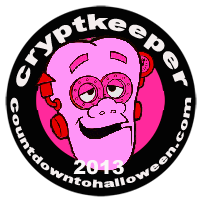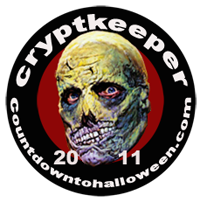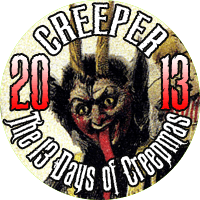 Rage is not at all what I was expecting. That’s not a bad thing. True, I didn’t know a damn thing about it before I saw it. Well, I did know that it has gotten some good buzz on the festival circuit, but that’s about it. That awesome poster had me thinking it would be an old school slasher flick along the lines of Nail Gun Massacre, Night School, Nightmare Beach, or any other classic “motorcycle helmeted psycho” movies. What I got instead was a cat and mouse thriller, and an effective and entertaining one at that, from the mind of writer/director/costar/cinematographer/editor/sound editor/effects supervisor/damn-near-one-man-crew Chris Witherspoon. With the exception of a couple of lapses into “modern horror” cliché crap visually; this is a well made and skillfully told taut ride that delivers far better than any of the big budget studio stuff being released lately.
Rage is not at all what I was expecting. That’s not a bad thing. True, I didn’t know a damn thing about it before I saw it. Well, I did know that it has gotten some good buzz on the festival circuit, but that’s about it. That awesome poster had me thinking it would be an old school slasher flick along the lines of Nail Gun Massacre, Night School, Nightmare Beach, or any other classic “motorcycle helmeted psycho” movies. What I got instead was a cat and mouse thriller, and an effective and entertaining one at that, from the mind of writer/director/costar/cinematographer/editor/sound editor/effects supervisor/damn-near-one-man-crew Chris Witherspoon. With the exception of a couple of lapses into “modern horror” cliché crap visually; this is a well made and skillfully told taut ride that delivers far better than any of the big budget studio stuff being released lately.
Dennis, a struggling writer, has decided that he really does love his wife, so he’d heading into the city to break things off with his mistress. While there, he runs afoul of a mysterious figure on a crotch rocket who may or may not be the jealous ex of his woman-on-the-side scorned. A cat and mouse game ensues between Dennis and The Biker (that’s the character’s actual name) that escalates from taunting and vandalism to physical violence. Dennis eventually loses his pursuer and returns home. The Biker, however, proves to be more determined to destroy Dennis than we thought. With the battle now on the home front, it appears that no one is safe and this fight won’t end until someone isn’t breathing.
Witherspoon has crafted a nice indie thriller here. It’s a very simple setup, but its one that could easily fall apart if not handled correctly. It draws its inspiration from Spielberg’s The Duel; a fact that is hammered home not so subtly when two characters discuss that movie in detail. I also see shades of The Hitcher (the original, not that godawful remake) in there. The pacing of the flick is right on. The first act in the city ramps up the tension and tightens the screw consistently. I’ve heard a couple of people say that it drug in the middle, but I think that little respite was necessary to make the Biker’s reappearance and the final act more forceful. I also liked that moments of black humor punctuated the suspense. One moment involving a mistaken identity I saw coming a mile away but it was so well played that it still had me laughing out loud. A great score helps the proceedings immensely. It’s minimalist in the right spots and hard hitting when it needs to be. I absolutely loved the “reveal” at the end. It makes the film more realistic at the last minute and makes the entire film more chilling in retrospect. It also puts it firmly in “this could happen to you” territory. It’s also refreshing that, in the end, nothing is alright and no one is going to live happily ever after.
 The acting is quite good. The supporting cast, of which there are very few, do well, and the three leads really shine. Rick Crawford, who plays Dennis, is excellent. He plays a very emotionally complex character well. He’s very expressive. He reminds me a little of Dustin Hoffman in Straw Dogs. My only issue with him isn’t with the acting, but the character. We feel for Dennis throughout the movie as he is bullied and tormented by The Biker, but later on in the flick he proves himself to be such a spineless, cowardly wuss that it’s difficult to muster much sympathy for him. I’m not 100% sure if that’s what they were going for, but I think they wanted the audience to develop a disdain for the character by the end, and they accomplished their goal. Audrey Walker, who plays Dennis’ wife Crystal, positively OWNS the final third of the movie. Her acting in the rape scene alone is award worthy. She doesn’t play a big role in the initial proceedings, but when the third act comes crashing in, she delivers a tour de force performance. Chris Witherspoon, in a very Argento like move, plays the killer in his own film. He steps in front of the camera as The Biker, and he plays him perfectly. There is a universally recognizable quality to him, which is needed for an “everyman psycho” type of character. At the same time, just like Voorhees, Myers, or any other masked, mute character, a certain amount of personality has to be portrayed purely through bodily movement. Witherspoon does just that. The combination of both makes the Biker oddly familiar yet coldly menacing. In other words, Witherspoon plays a great villain.
The acting is quite good. The supporting cast, of which there are very few, do well, and the three leads really shine. Rick Crawford, who plays Dennis, is excellent. He plays a very emotionally complex character well. He’s very expressive. He reminds me a little of Dustin Hoffman in Straw Dogs. My only issue with him isn’t with the acting, but the character. We feel for Dennis throughout the movie as he is bullied and tormented by The Biker, but later on in the flick he proves himself to be such a spineless, cowardly wuss that it’s difficult to muster much sympathy for him. I’m not 100% sure if that’s what they were going for, but I think they wanted the audience to develop a disdain for the character by the end, and they accomplished their goal. Audrey Walker, who plays Dennis’ wife Crystal, positively OWNS the final third of the movie. Her acting in the rape scene alone is award worthy. She doesn’t play a big role in the initial proceedings, but when the third act comes crashing in, she delivers a tour de force performance. Chris Witherspoon, in a very Argento like move, plays the killer in his own film. He steps in front of the camera as The Biker, and he plays him perfectly. There is a universally recognizable quality to him, which is needed for an “everyman psycho” type of character. At the same time, just like Voorhees, Myers, or any other masked, mute character, a certain amount of personality has to be portrayed purely through bodily movement. Witherspoon does just that. The combination of both makes the Biker oddly familiar yet coldly menacing. In other words, Witherspoon plays a great villain. When it comes to the violence, this is one of those flicks where you can tell just how big of a horror fan the reviewer is. I’ve seen reviewers call the flick “brutally violent” and talk about gore. These must be the more mainstream movie watchers who are unaccustomed to real gore. The more seasoned horror freaks talk about how the film doesn’t focus on the carnage. I think they’re understating the case. The only scene that I would call truly brutal is the rape scene. Make no mistake; that scene is brutal. Those particularly sensitive to sexual violence might have problems getting through it. Most of the other mayhem takes place either off screen or with shaky cam and rapid edits obscuring our view. I’ll get back to that in a moment. I’ll also contradict what I’m about to say two paragraphs down, but get over it. That’s how I roll. Anyway, the film doesn’t focus on the violence going on, it focuses more on the character’s reactions to what is going on. I really dug that. It made the violence more real, and therefore more affecting. For example, during the rape scene we could have watched what The Biker was actually doing to Crystal the whole time, and it would have been harrowing. Instead, we see what’s going on, but the camera focuses more on the faces of Crystal and Dennis while the deed is being done, and it hits like a punch in the gut. With actors as strong as Walker and Crawford, focusing on their emotional reactions made it so much more intense than just showing the action would have. This focus on the effect of the violence rather than the act itself is thematic as well as visual. For example, throughout the first part of the movie, The Biker’s attacks on Dennis are far shorter than the time we spend watching Dennis fall apart as a result of them. Good call on Witherspoon’s part.
When it comes to the violence, this is one of those flicks where you can tell just how big of a horror fan the reviewer is. I’ve seen reviewers call the flick “brutally violent” and talk about gore. These must be the more mainstream movie watchers who are unaccustomed to real gore. The more seasoned horror freaks talk about how the film doesn’t focus on the carnage. I think they’re understating the case. The only scene that I would call truly brutal is the rape scene. Make no mistake; that scene is brutal. Those particularly sensitive to sexual violence might have problems getting through it. Most of the other mayhem takes place either off screen or with shaky cam and rapid edits obscuring our view. I’ll get back to that in a moment. I’ll also contradict what I’m about to say two paragraphs down, but get over it. That’s how I roll. Anyway, the film doesn’t focus on the violence going on, it focuses more on the character’s reactions to what is going on. I really dug that. It made the violence more real, and therefore more affecting. For example, during the rape scene we could have watched what The Biker was actually doing to Crystal the whole time, and it would have been harrowing. Instead, we see what’s going on, but the camera focuses more on the faces of Crystal and Dennis while the deed is being done, and it hits like a punch in the gut. With actors as strong as Walker and Crawford, focusing on their emotional reactions made it so much more intense than just showing the action would have. This focus on the effect of the violence rather than the act itself is thematic as well as visual. For example, throughout the first part of the movie, The Biker’s attacks on Dennis are far shorter than the time we spend watching Dennis fall apart as a result of them. Good call on Witherspoon’s part. That brings me to the look of the film, meaning the cinematography, editing and overall visual style. I think this is the movie’s greatest strength as well as its greatest weakness. For the most part, this movie looks amazing, especially when you take the budget into account. It has a cool saturated color palate that really makes the action pop. Witherspoon proves that he has a real gift for setting up great shots and moving the camera with purpose. Throughout the movie, it has a very old school feel without seeming dated. For the most part, it doesn’t rely on new school camera “trickery,” it’s just beautiful shots that are edited in such a way that the visual power really gets a chance to shine. It’s refreshing to see a film that’s not a “throwback” using this kind of back to basics approach of a movie just plain ‘ol being shot well. There’s one shot, a simple close-up of Dennis’ eyes, that is lit, framed, and captured so perfectly that I paused it just to admire the shot for a moment.
That brings me to the look of the film, meaning the cinematography, editing and overall visual style. I think this is the movie’s greatest strength as well as its greatest weakness. For the most part, this movie looks amazing, especially when you take the budget into account. It has a cool saturated color palate that really makes the action pop. Witherspoon proves that he has a real gift for setting up great shots and moving the camera with purpose. Throughout the movie, it has a very old school feel without seeming dated. For the most part, it doesn’t rely on new school camera “trickery,” it’s just beautiful shots that are edited in such a way that the visual power really gets a chance to shine. It’s refreshing to see a film that’s not a “throwback” using this kind of back to basics approach of a movie just plain ‘ol being shot well. There’s one shot, a simple close-up of Dennis’ eyes, that is lit, framed, and captured so perfectly that I paused it just to admire the shot for a moment.
Then, when the Biker physically attacks Dennis, the shaky cam and rapid fire editing starts. Why, oh why, did Witherspoon have to do that? If you read this blog, you know how much I abhor shaky cam and rapid fire editing during action sequences. It mars an otherwise gorgeous movie. The idea behind this technique is that it’s supposed to add intensity to a violent scene. It actually does quite the opposite, lessening its impact. Remember when I said that I liked the way that the violence is less important than its mental effect on the characters? Well, if the camera had been allowed to gaze at the violence in the same way that it pores over the rest of the movie, the flick could have had its cake and ate it too. Had the violence been allowed to shine AND been coupled with the focus on its emotional toll, it would have been amazing! Next to the camera mastery of the rest of the film, however, the style used to shoot these scenes really stood out like a sore thumb and took me out of the movie. The same goes for some of the digital manipulation of the film, such as when the screen dissolves into black and white for flashbacks, or the annoying “jump cuts of basically the same shot” thing everyone does these days. Witherspoon’s shots are more than strong enough to speak for themselves without employing these “cheat” tactics. I think he should have had more confidence in the action itself and not felt the need to use techniques that are usually used to hide deficiencies, because that weren’t there to hide in the first place. These few moments frustrated the hell out of me. I realize that these aren’t so much mistakes as artistic choices, but I feel that they are choices that hurt the film.
 Chris Witherspoon is definitely a name I’ll be watching out for in the future. Despite him embracing some abhorrent recent trends in horror film-making, he’s got a lot of skill, real talent, and I’m excited to see what he comes up with in the future. I really liked Rage. It was one of those “slow burn to an intense climax” films, which are sadly becoming a lost art. Honestly, I’m surprised this flick isn’t better known than it is. It definitely deserves wider recognition. Rage looks great, has a simple but classic story, features great acting, and holds its suspense commendably. Plus, it’s got chainsaw murders. How can you not love a flick with chainsaw murders? One and a half severed thumbs up. Nathan says check it out.
Chris Witherspoon is definitely a name I’ll be watching out for in the future. Despite him embracing some abhorrent recent trends in horror film-making, he’s got a lot of skill, real talent, and I’m excited to see what he comes up with in the future. I really liked Rage. It was one of those “slow burn to an intense climax” films, which are sadly becoming a lost art. Honestly, I’m surprised this flick isn’t better known than it is. It definitely deserves wider recognition. Rage looks great, has a simple but classic story, features great acting, and holds its suspense commendably. Plus, it’s got chainsaw murders. How can you not love a flick with chainsaw murders? One and a half severed thumbs up. Nathan says check it out.









No comments:
Post a Comment